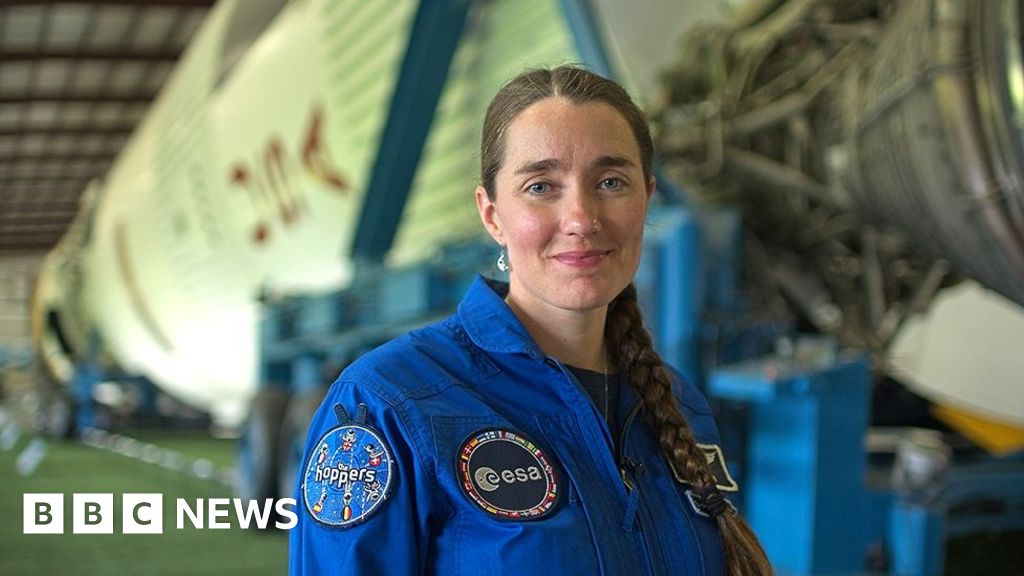BBC News science team
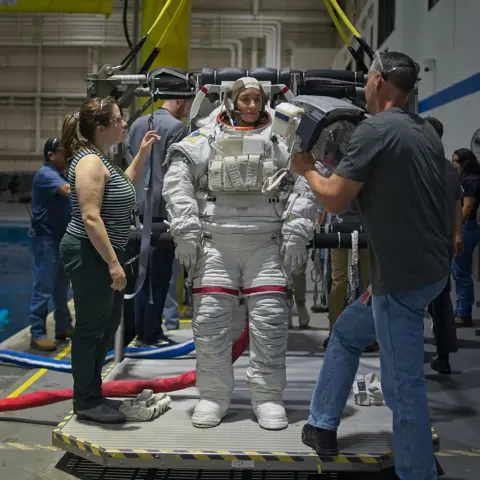
Kevin Church/BBC
Rosemary Coogan finds herself in a flurry of activity as a team preps her in a spacesuit.
The process takes roughly 45 minutes, culminating in her helmet being delicately placed over her head.
As the British astronaut gears up for her toughest challenge yet, she will be evaluated on her readiness for a spacewalk at NASA’s Neutral Buoyancy Laboratory in Houston, Texas.
The facility boasts a 12-meter (40 feet) deep pool that holds a full-scale replica of the International Space Station (ISS), simulating weightlessness on Earth.
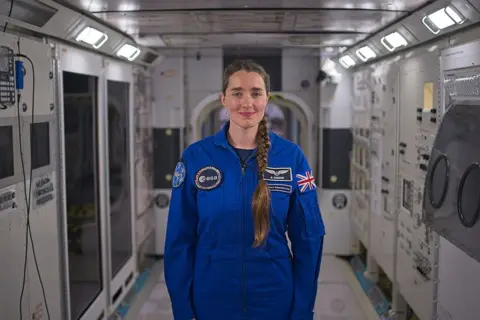
Kevin Church/BBC
“It’s a significant day,” Rosemary remarks before her dive, expected to last over six hours. “The physical and mental intensity is substantial.”
Despite the challenges, she appears at ease, smiling and waving as her platform descends into the water.
From a young age, Dr. Rosemary Coogan dreamed of being an astronaut, a dream that often felt out of reach.
“In school, career days typically don’t introduce you to astronauts,” she shares. “There’s little exposure to their stories.”
Choosing astrophysics as her field, she thought her aspirations were distant. However, when the European Space Agency sought new recruits for space missions, Rosemary applied and was selected from over 22,000 applicants.
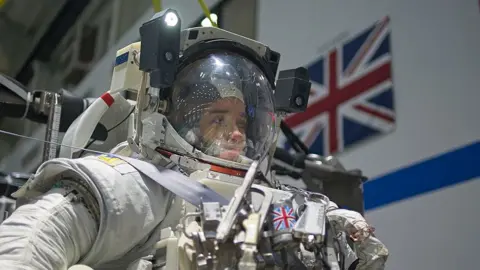
Kevin Church/BBC
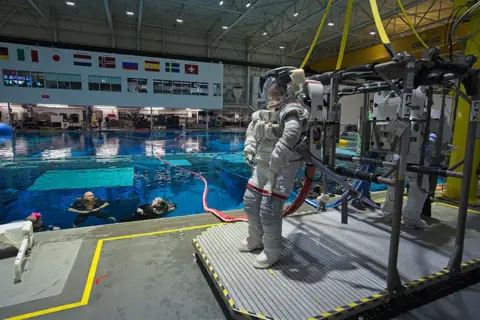
Kevin Church/BBC
The ESA plans to send Rosemary to the International Space Station (ISS) by 2030, joining the ranks of Britons like Helen Sharman and Tim Peake.
Rosemary has dedicated the past six months to training at the Johnson Space Center. Not only can she explore the exterior of the simulated ISS, but she can also enter another full-scale mock-up in a vast hangar.
Touring the lab’s interlinked modules feels tight, but she emphasizes the breathtaking views from above.
“While it may seem isolated, it creates a greater sense of connection to being outdoors, reducing that claustrophobic feeling,” she explains.
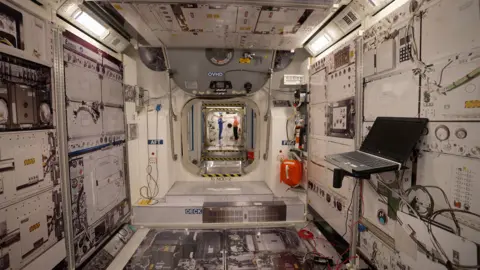
Kevin Church/BBC
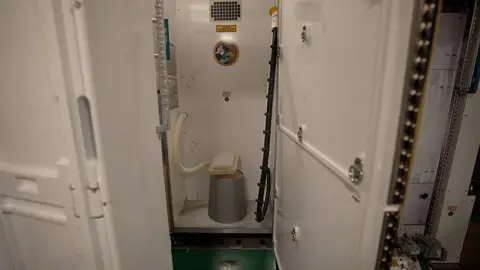
Kevin Church/BBC
Rosemary’s training encompasses all aspects of space travel, including using the onboard toilet.
“The lower compartment is for solid waste,” she explains, pointing to a vintage-looking toilet. “The funnel here connects to a suction system for liquid waste.”
Female astronauts can opt to suppress their periods using medication, but it’s not mandatory, Rosemary notes.
“There’s a filter positioned atop the cone for urination, which prevents any particles, including blood, from entering the urine system,” she clarifies.
It’s essential to separate urine as it’s purified and treated for reuse as drinking water, she highlights.
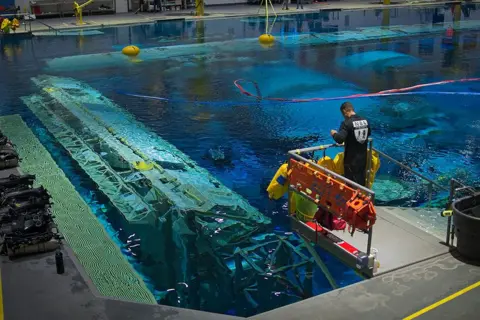
Kevin Church/BBC
While submerged in the pool, divers continuously adjust Rosemary’s buoyancy to replicate microgravity as authentically as possible.
With careful movements, she ensures she remains secured to the structure using two hooks.
Each handhold is meticulously selected along the module’s bars, precisely mirroring the actual ISS, essential for developing muscle memory for future spacewalks far above Earth.
This process is laborious and demanding, requiring significant upper body strength and stamina in the heavy suit.
“Every movement is mentally rehearsed – you must be efficient with your energy,” Rosemary states. “You want to avoid mistakes that necessitate do-overs.”
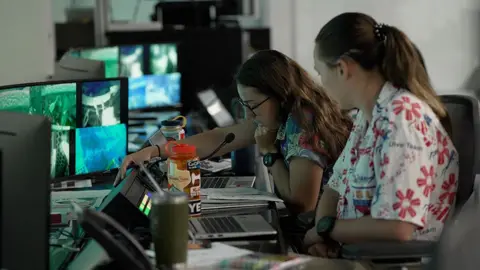
Kevin Church/BBC
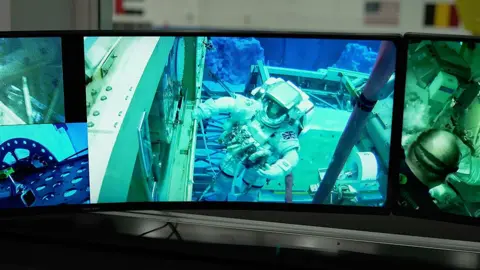
Kevin Church/BBC
With guidance from former space station commander Aki Hoshide, who has completed four spacewalks, Rosemary learns that the journey for novice astronauts is full of challenges.
“Initially, there’s an overwhelming amount of information and skills to acquire,” Aki notes. “It’s about taking baby steps, but I can see their excitement growing each time they jump into the pool.”
Rosemary takes us to see a Saturn V rocket – the same that ferried the Apollo astronauts to the Moon in 1969. As NASA prepares for a return to the lunar surface with its Artemis program, European astronauts are set to join later missions. With a projected 35-year career ahead, Rosemary might even become the first Briton to step foot on the Moon.
“It’s incredibly exciting that humanity is venturing back to the Moon, and I would be absolutely thrilled to be part of that,” she comments.
As Rosemary nears the conclusion of her underwater spacewalk evaluation, a surprise challenge arises.
She calls for a communication check with her diving partner, only to be met with silence. On the monitor, he remains still; unbeknownst to her, he has been instructed to act unresponsive. Her task now is to assess his condition and assist him back to the airlock.
Despite her fatigue, Rosemary steadily maneuvers, successfully bringing him to safety.
“Rosemary embodies the endurance of a champion. She excelled today,” praises Jenna Hanson, one of NASA’s spacewalk instructors overseeing her progress. “We’re delighted with her performance; she’s doing fantastic.”
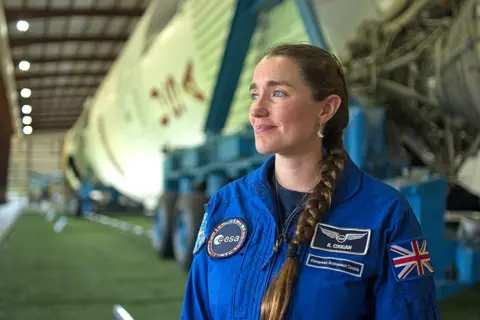
Kevin Church/BBC
As the spacewalk concludes, Rosemary’s platform is raised from the pool. The support crew assists her out of her suit. Though visibly tired, she smiles as her helmet is taken off.
“It was a tough task and a challenging rescue,” she reflects, “yet an enjoyable experience overall.”
Her dedication brings her closer to her aspiration of reaching space.
“It’s incredible,” Rosemary shares. “Experiencing the real space station, gazing at the stars and Earth simultaneously, would be the ultimate achievement.”

